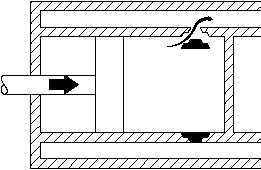Pumps
DOE-HDBK-1018/1-93
POSITIVE DISPLACEMENT PUMPS
Power pumps typically have high efficiency and are capable of developing very high pressures.
Figure 13 Single-Acting and Double-Acting Pumps
They can be driven by either electric motors or turbines. They are relatively expensive pumps
and can rarely be justified on the basis of efficiency over centrifugal pumps. However, they are
frequently justified over steam reciprocating pumps where continuous duty service is needed due
to the high steam requirements of direct-acting steam pumps.
In general, the effective flow rate of reciprocating pumps decreases as the viscosity of the fluid
being pumped increases because the speed of the pump must be reduced. In contrast to
centrifugal pumps, the differential pressure generated by reciprocating pumps is independent of
fluid density. It is dependent entirely on the amount of force exerted on the piston. For more
information on viscosity, density, and positive displacement pump theory, refer to the handbook
on Thermodynamics, Heat Transfer, and Fluid Flow.
Rev. 0
ME-03
Page 21








